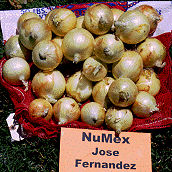NuMex Jose Fernandez

The New Mexico Agricultural Experiment Station announces the naming and release of NuMex Jose Fernandez onion variety. NuMex Jose Fernandez is a yellow, intermediate, open pollinated variety adapted for spring seeding or transplanting in southern New Mexico. NuMex Jose Fernandez was developed by professor Joe Corgan of the Department of Agronomy and Horticulture.
In 1984 seven populations were intercrossed to produce a population with a broad gene pool to serve as a genetic source for selection programs to produce open-pollinated varieties. The seven included NuMex BR 1, Buffalo, Ben Shemen, a progeny developed from a Ben Shemen x Sweet Spanish cross, Peckham Yellow Sweet Spanish, a progeny developed from Tucker Yellow Sweet Spanish (YSS) x PI249538 from Greece, and a progeny developed from El Capitan X PI249538. The PI 249538 accession was supplied by the Northeastern Plant Introduction Station, Geneva, NY. It tested highly resistant to pink root disease, and was included for that trait. Populations were intercrossed in 1984 and seed was collected separately from each population. These seeds were planted in early fall, 1984, to induce bolting from seed, and the progenies were intercrossed in 1985, with no selection from the 1984 seed sources. Progenies from the 1985 intercross were planted for bulb selection in 1986, and selected bulbs were planted for intercrossing. The cycle was repeated in 1988. The bulbs selected from the 1989 intercross were combined into one mass and tested as 9169. Selected bulbs from 9169 were massed to produce 9362. Breeder's seed for NuMex Jose Fernandez was produced by seed to seed increase from 9362. (To the right is a picture of NuMex Jose Fernandez (98).)
Maternal parents thought to be in N cytoplasm included in NuMex Jose Fernandez are Ben Shemen, Peckham YSS, and Tucker YSS. NuMex BR 1, Buffalo, and El Capitan contributed S cytoplasm. Several parents contributed genes for male sterility (ms). NuMex Jose Fernandez should be an excellent source from which to select both A and B lines for hybrid varieties. No attempt was made to estimate the relative percentages of A and B cytoplasm, nor the frequency of ms genes.
Selection criteria included: Intermediate maturity of July 10 at Las Cruces NM, resistance to pink root disease (Pyrenochaeta terrestris ), globe shape, bulb firmness and single centers, and large bulb size. Bulbs were selected at maturity in fields severely infested with P. terrestris.
NuMex Jose Fernandez matures about July 10 from direct seeding, or about June 25 from transplanting in southern New Mexico. Maturity has been consistently about a week later than Cimarron. NuMex Jose Fernandez is highly resistant to pink root disease, and produces high yields on pink root infested soils. Bulbs are predominantly medium depth globe shape, and firm. Scale color is light yellow (straw colored), similar to Sweet Spanish varieties, and only slightly darker than the grano types like NuMex BR 1 or NuMex Sunlite. Necks are small. Foliage color is medium green, similar to that of most Sweet Spanish types.
NuMex Jose Fernandez is suggested for testing from transplanting or direct seeding wherever intermediate onion varieties are grown. It is highly promising for production in southern New Mexico.